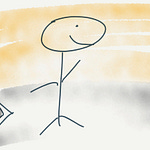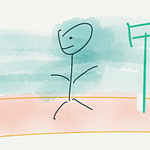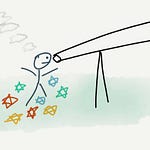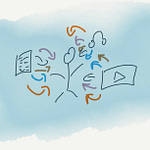Frameworks
What comes to mind when you hear the word framework?
I’ll be honest, I didn’t use this word a lot till late 2019 and now it seems to be my go-to word in almost every discussion around content. So why is a term that has mostly been used for software development and industrial processes fast becoming the core of every creative and content exercise?
Let’s first take a step back and understand the modern creation process. The way I see it ( and in many ways have learned to see it) creation of all forms of creative and content in modern marketing isn’t a purely artistic or creative exercise, it has always involved a large number of logistical pieces that hold it together. And as the content ecosystem and what we create within it has become more and more complex, its made the process of managing the conceptualization, creation, and deployment of each creative or content asset ( consider an asset as any single piece of creative you create, no matter how big or small) even more complex. And add to that the advent of technology into each of these stages of the creation process and in came the term “ Framework”.
So, now that we have context.. let’s just google the word “Content framework” and see what pops up.
“ It’s a structured plan of attack on how you will go about creating content, why you’ll be creating it, for whom you will be creating it, and how it factors into the buying process”
Or as I would compress the above “ Your framework is your guidebook and toolset to create all forms of content”.
So, now that we know what it is,
how do you go about building it?
And how can knowing the build help you in your career and creation focus.?
There are three simple steps which can be used to build any framework..which could be to make a series of content posts for social media, a series of ads across all mediums, building out a long-form web series or even a film or it could include building all of the above over a period of time.
Hoard data & Understand the Macro. At most times we look at every piece of content in a focussed silo. The most important part of building a framework is to take a wider POV.. start by looking at what practices and processes people follow ( not just in the same exact kind of content but look broader) collect all that information and distill it.. start with anything u can find and bring it down to what could really work for you., this process and building the knack for it takes time. So it’s fine if you end up following frameworks others have done and slowly over time learn to add your insights to evolve them in your own distinct way. This also helps you not just understand how to build a broad framework around anything but also makes you constantly store information in daily life that you could use for a framework you build tomorrow. No idea is original and neither is a framework.
Build in a Tech backbone. Once you have all the information and a broad framework, see what tools modern technology allows us to make it better, make it more new-age, or just simpler. And this doesn’t have to be something that’s too hardcore, We live in a time when the tools we have at our disposal on the internet and on our phones allow us to do amazing things, use those if they make the process better and more efficient and honestly the way I see it these also make it simpler to explain to anyone under the sun. So maybe use Canva for design or use an iPhone for capturing certain kinds of footage in compressed areas or even come up with your own hack/”jugaad” which might just be the Gamechanger you bring into any framework.
Test, recalibrate, create, and test again. The one thing we need to take away from software builds is the idea of always being in a developer beta mode. We create so much content that if we build our process framework to be a constant process of trying stuff out, putting it out there, seeing how it works, learning from it, and making the necessary changes to our framework.. then we ensure that we’re always updated to the needs of now as well as being far more efficient in our processes.. quality could fluctuate sometimes but that’s how you learn about what doesn’t work.. and in the larger lens of things, one failed piece of content can teach more than any amount of time used to perfect it.
so, this in a broad nutshell is how frameworks are built! Along with the nuts and bolts that help create and evolve them. And in this complex world we are all trying to navigate and create within, understanding how to build structure around the chaos of the ocean that is the modern content industry will make you the person who builds value for yourself by navigating everyone around u through its many waves and storms.
( ✌🏽I might do a workshop on building frameworks soon so a deeper dive then.)
Tough decisions
We live in a time of tremendous disruption and change, it’s making us question every aspect of what we do, how we do, and why we do as companies and individuals. And while most times the changes we need to make seem obvious if we look at it from a point of clarity.. we hold back, we procrastinate and we lose crucial time in making the changes we need to which can ensure we ride through the storm in front of us. And when you think about it, there is one primary reason why we don’t act.. tradition.
In his phenomenal book “Ride of a lifetime” Bob Iger says
“I know why companies fail to innovate, It’s tradition. Tradition generates so much friction, every step of the way.”
so, learn from your emotions to ensure every decision has heart in it, but don’t let tradition hold you back by trying to fool you into thinking that it’s your heart speaking to you, rather it’s just tradition telling you that things have always been done a certain way and that changing them will do no actual good and will anyway be too hard to bear. So, respect tradition.. learn from it but don’t fear changing it around in the way the situation demands.
The Force
One of my learning’s over the last 7 months of the pandemic is to find a few things ( it could also just be one thing) to be your anchor. It could be a basic morning ritual you build around making your coffee in the morning or your exercise routine, or just sitting in silence for a few minutes a day. We’ve never been more connected yet so apart as human beings and never so disconnected from our own selves in the barrage of stuff we let the world throw at us. So find a few things in your day that become your anchors, which help you spend time with yourself without plugging into anything else. This one act can make you feel more connected to yourself than you have in a long time.. because if you find the force inside yourself then the force emanates from you to the world around you. Or as Chirrut Imwe in Star Wars Rogue one said,
“I’m one with the force and the force is with me”
stay safe and catch you guys next week.
✌🏽
@VarunDuggi
p:s- please share feedback on what you liked and didn’t like about the newsletter, the one thing I really want to do is evolve this to be put together for you in the best possible way. and also apologies for the random beeps in between the audio-version, “software glitches” 🙈














Share this post